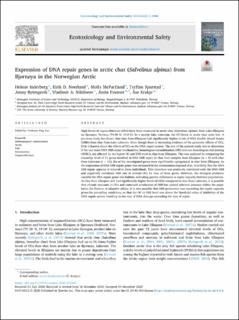| dc.contributor.author | Inderberg, Helene | |
| dc.contributor.author | Neerland, Eirik D. | |
| dc.contributor.author | Mcpartland, Molly | |
| dc.contributor.author | Sparstad, Torfinn | |
| dc.contributor.author | Bytingsvik, Jenny | |
| dc.contributor.author | Nikiforov, Vladimir A | |
| dc.contributor.author | Evenset, Anita | |
| dc.contributor.author | Krøkje, Åse | |
| dc.date.accessioned | 2021-02-09T09:05:07Z | |
| dc.date.available | 2021-02-09T09:05:07Z | |
| dc.date.created | 2021-01-13T20:48:30Z | |
| dc.date.issued | 2021 | |
| dc.identifier.issn | 0147-6513 | |
| dc.identifier.uri | https://hdl.handle.net/11250/2726780 | |
| dc.description.abstract | High levels of organochlorines (OCs) have been measured in arctic char (Salvelinus alpinus) from Lake Ellasjøen on Bjørnøya, Norway (74.30°N, 19.0°E). In a nearby lake, Laksvatn, the OC-levels in arctic char were low. A previous study has shown that char from Ellasjøen had significantly higher levels of DNA double strand breaks (DSBs) than char from Lake Laksvatn. Even though there is increasing evidence of the genotoxic effects of OCs, little is known about the effects of OCs on the DNA repair system. The aim of the present study was to determine if the two main DNA DSB repair mechanisms, homologous recombination (HR) and non-homologous end-joining (NHEJ), are affected by the higher OC and DSB level in char from Ellasjøen. This was analysed by comparing the transcript level of 11 genes involved in DNA DSB repair in char liver samples from Ellasjøen (n = 9) with char from Laksvatn (n = 12). Six of the investigated genes were significantly upregulated in char from Ellasjøen. As the expression of DNA DSB repair genes was increased in the contaminant-exposed char, it is likely that the DNA DSB repair capacity is induced in these individuals. This induction was positively correlated with the DNA DSB and negatively correlated with one or several OCs for four of these genes. However, the strongest predictor variable for DNA repair genes was habitat, indicating genetic differences in repair capacity between populations. As char from Ellasjøen still had significantly higher levels of DSBs compared to char from Laksvatn, it is possible that chronic exposure to OCs and continued production of DSB has caused selective pressure within the population for fixation of adaptive alleles. It is also possible that DSB production was exceeding the repair capacity given the prevailing conditions, or that the OC or DSB level was above the threshold value of inhibition of the DNA repair system resulting in the rate of DNA damage exceeding the rate of repair. | en_US |
| dc.language.iso | eng | en_US |
| dc.publisher | Elsevier | en_US |
| dc.rights | Attribution-NonCommercial-NoDerivatives 4.0 Internasjonal | * |
| dc.rights.uri | http://creativecommons.org/licenses/by-nc-nd/4.0/deed.no | * |
| dc.title | Expression of DNA repair genes in arctic char (Salvelinus alpinus) from Bjørnøya in the Norwegian Arctic | en_US |
| dc.type | Peer reviewed | en_US |
| dc.type | Journal article | en_US |
| dc.description.version | publishedVersion | en_US |
| dc.source.volume | 210 | en_US |
| dc.source.journal | Ecotoxicology and Environmental Safety | en_US |
| dc.identifier.doi | https://doi.org/10.1016/j.ecoenv.2020.111846 | |
| dc.identifier.cristin | 1870950 | |
| dc.description.localcode | © 2020 Published by Elsevier Inc. This is an open access article under the CC BY-NC-ND license (http://creativecommons.org/licenses/by-nc-nd/4.0/). | en_US |
| cristin.ispublished | true | |
| cristin.fulltext | original | |
| cristin.qualitycode | 2 | |

